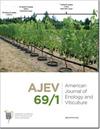结构转变对红酒酚醛聚合物沉淀性和极性的影响
IF 1.8
3区 农林科学
Q3 BIOTECHNOLOGY & APPLIED MICROBIOLOGY
引用次数: 6
摘要
浓缩单宁和聚合色素是红酒必不可少的成分,有助于颜色稳定,味道和口感。红酒中的酚类聚合物由黄烷-3-醇单体和花青素组成,会引起涩味的感觉。由于原花青素聚合物的化学异质性,确定聚合物结构特征的分析工具受到限制。花青素的掺入增加了结构的复杂性,甚至更多,使得几乎不可能评估结构对感知到的涩味的影响。为了更好地了解红酒聚合物的结构多样性,本研究采用强制陈化和flash分馏相结合的方法,揭示了红酒多酚类聚合物与极性和亲水两种理化性质之间的关系。采用极性、辛醇-水分配系数、蛋白质沉淀法、超高效液相色谱-质谱法和颜色对红酒馏分进行表征。在强制陈酿过程中,葡萄酒中的单宁浓度下降,而相应提取物中的单宁浓度保持不变,表明沉淀行为发生了变化。同时,可沉淀的聚合色素的增加导致假设将花青素纳入单宁分子改变了它们与红葡萄酒多糖和蛋白质的相互作用,降低了单宁读数。在不同的flash组分中发现单宁和聚合色素表明聚合物的可沉淀性受其物理化学性质的影响,而这些物理化学性质又取决于聚合程度和着色程度。本研究结果表明,红葡萄酒的涩味及其亚品质可能与强制陈酿过程中可沉淀聚合物色素的增加以及它们与葡萄酒多糖的相互作用增强有关,从而增加了对涩味机制的理解。本文章由计算机程序翻译,如有差异,请以英文原文为准。
Effect of Structural Transformations on Precipitability and Polarity of Red Wine Phenolic Polymers
Condensed tannins and polymeric pigments are essential red wine components that contribute to color stability, taste, and mouthfeel. Phenolic polymers in red wine consist of flavan-3-ol monomers and anthocyanins and cause the perception of astringency. Due to the chemical heterogeneity of proanthocyanidin polymers, analytical tools to determine the polymers’ structural features are limited. Incorporation of anthocyanins increases the structural complexity even more and makes it almost impossible to assess the influence of structure on the perceived astringency. To better understand the structural diversity of red wine polymers, this study combines forced aging and FLASH-fractionation of polyphenolic wine extracts to reveal the relationship between phenolic polymers and two physicochemical properties: polarity and hydrophilicity. Red wine fractions were characterized using polarity, the octanol-water partitioning coefficient, protein precipitation assay, ultra high-performance liquid chromatography-mass spectrometry, and color. Tannin concentrations in wine decreased during forced aging and were constant in the corresponding extracts, suggesting alteration of the precipitation behavior. A simultaneous increase in precipitable polymeric pigments leads to the assumption that incorporating anthocyanins into tannin molecules alters their interactions with red wine polysaccharides and proteins, lowering tannin readings. Finding tannins and polymeric pigments in different FLASH-fractions indicates that precipitability of polymers is affected by their physicochemical properties, which in turn depend on the degree of polymerization as well as degree of pigmentation. The results of this study show that red wine astringency and its sub-qualities may be related to the increase in precipitable polymeric pigments during forced red wine aging and their putative enhanced interaction with wine polysaccharides, increasing understanding of astringency mechanisms.
求助全文
通过发布文献求助,成功后即可免费获取论文全文。
去求助
来源期刊

American Journal of Enology and Viticulture
农林科学-生物工程与应用微生物
CiteScore
3.80
自引率
10.50%
发文量
27
审稿时长
12-24 weeks
期刊介绍:
The American Journal of Enology and Viticulture (AJEV), published quarterly, is an official journal of the American Society for Enology and Viticulture (ASEV) and is the premier journal in the English language dedicated to scientific research on winemaking and grapegrowing. AJEV publishes full-length research papers, literature reviews, research notes, and technical briefs on various aspects of enology and viticulture, including wine chemistry, sensory science, process engineering, wine quality assessments, microbiology, methods development, plant pathogenesis, diseases and pests of grape, rootstock and clonal evaluation, effect of field practices, and grape genetics and breeding. All papers are peer reviewed, and authorship of papers is not limited to members of ASEV. The science editor, along with the viticulture, enology, and associate editors, are drawn from academic and research institutions worldwide and guide the content of the Journal.
 求助内容:
求助内容: 应助结果提醒方式:
应助结果提醒方式:


